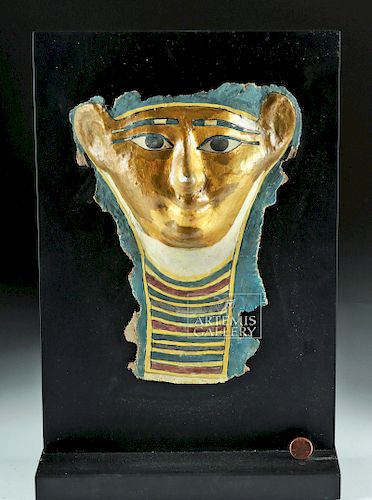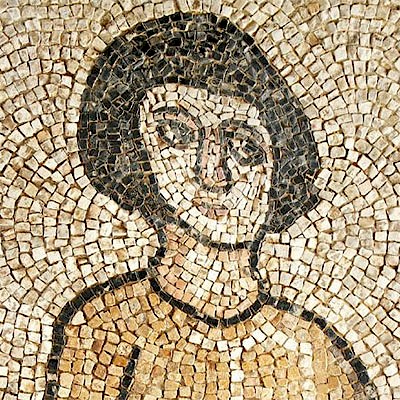Egyptian Ptolemaic Gilded Cartonnage Sarcophagus Mask
Lot 2
About Seller
Artemis Gallery
686 S Taylor Ave, Ste 106
Louisville, CO 80027
United States
Selling antiquities, ancient and ethnographic art online since 1993, Artemis Gallery specializes in Classical Antiquities (Egyptian, Greek, Roman, Near Eastern), Asian, Pre-Columbian, African / Tribal / Oceanographic art. Our extensive inventory includes pottery, stone, metal, wood, glass and textil...Read more
Estimate:
$5,000 - $7,500
Absentee vs Live bid
Two ways to bid:
- Leave a max absentee bid and the platform will bid on your behalf up to your maximum bid during the live auction.
- Bid live during the auction and your bids will be submitted real-time to the auctioneer.
Bid Increments
| Price | Bid Increment |
|---|---|
| $0 | $25 |
| $300 | $50 |
| $1,000 | $100 |
| $2,000 | $250 |
| $5,000 | $500 |
| $10,000 | $1,000 |
| $20,000 | $2,500 |
| $50,000 | $5,000 |
| $100,000 | $10,000 |
| $200,000 | $20,000 |
About Auction
By Artemis Gallery
Aug 2, 2018
Set Reminder
2018-08-02 10:00:00
2018-08-02 10:00:00
America/New_York
Bidsquare
Bidsquare : Antiquities | Egypt, Greece, Italy, Asia
https://www.bidsquare.com/auctions/artemis-gallery/antiquities-egypt-greece-italy-asia-3352
Featuring two incredible collections - one in storage for more than 20 years! Artemis Gallery info@artemisgallery.com
Featuring two incredible collections - one in storage for more than 20 years! Artemis Gallery info@artemisgallery.com
- Lot Description
Ancient Egypt, Ptolemaic Period, ca. 332 to 30 BCE. A fabulous gilded cartonnage sarcophagus mask, displaying quintessential Egyptian beauty, made from layers of plaster-covered linen and painted with vibrant pigments. The face is defined by its sensual almond-shaped eyes outlined in blue and black pigment with slender blue-and-white eyebrows set above. Large cupped ears are framed by a blue and yellow headdress which drapes over the center of her chest, and a petite nose and slight smile evoke a sense of elegance and grace. A large pectoral of red, blue, and purple bands are each separated by alternating gold stripes. The verso of the mask is concave enough to fit over the head of a linen-wrapped mummy. A wonderful example that exudes a sense of human life even though it belongs to this funerary tradition. Custom wooden display stand included. Size: 7.75" W x 10.375" H (19.7 cm x 26.4 cm); 13.875" H (35.2 cm) on included custom stand.
Ancient Egyptians believed it was of the utmost importance to preserve a body of the deceased, because the soul needed a place to reside after the death. Preservation of the body was done via mummification - a process involving the removal of internal organs that were placed in canopic jars, wrapping body in linen, and then embalming. Death masks like this example were created so that the soul could recognize the body and return to it. For this reason, death masks were made in the relative likeness of the deceased.
Artisans were able to employ the use of different materials when crafting sarcophagi or any elements to be placed atop the deceased. Earlier masks were carved from wood, while later ones were made of cartonnage, a material made from papyrus or linen and soaked in plaster which was then applied to a wooden mold. Royal death masks, perhaps the most famous being that of Tutankhamen, were made from precious metals. All death masks were intended to resemble the deceased subject; however, eyes were always slightly enlarged and lips presented in a subtle smile, as we see in this example.
For a stylistically-similar example presented on its original mummy, please see The Metropolitan Museum of Art, accession number 12.182.48a: https://www.metmuseum.org/art/collection/search/677636
Provenance: private East Coast, USA collection
All items legal to buy/sell under U.S. Statute covering cultural patrimony Code 2600, CHAPTER 14, and are guaranteed to be as described or your money back.
A Certificate of Authenticity will accompany all winning bids.
We ship worldwide and handle all shipping in-house for your convenience.
#135429Mask reassembled from five or six large pieces, and has been re-lacquered for stabilization. Overpainting on areas of chest, neck, peripheries, eyebrows, and face, with some areas of new plaster over some obverse areas. Surface wear commensurate with age, fading and chipping to areas of pigmentation, light chipping and losses to gilding, and losses along peripheries. Light earthen deposits throughout.Condition
- Shipping Info
-
All shipping is handled in-house for your convenience. Your invoice from Artemis Gallery will include shipping calculation instructions. If in doubt, please inquire BEFORE bidding for estimated shipping costs for individual items.
-
- Buyer's Premium



 EUR
EUR CAD
CAD AUD
AUD GBP
GBP MXN
MXN HKD
HKD CNY
CNY MYR
MYR SEK
SEK SGD
SGD CHF
CHF THB
THB














